Spatiotemporal Variations of Aerosol Optical Depth and the Spatial Heterogeneity Relationship of Potential Factors Based on the Multi-Scale Geographically Weighted Regression Model in Chinese National-Level Urban Agglomerations
Abstract
:1. Introduction
2. Materials and Methods
2.1. Study Areas
2.2. Materials
2.2.1. MCD19A2
2.2.2. Auxiliary Data
2.3. Methodology
2.3.1. Theil–Sen Median Method
2.3.2. Mann–Kendall Test
2.3.3. Random Forest (RF) Regression Model
2.3.4. Multi-Scale Geographically Weighted Regression (MGWR)
3. Results
3.1. Spatial Pattern of AOD
3.1.1. Spatial Distribution of Annual AOD in Ten Urban Agglomerations
3.1.2. Frequency Distribution of Annual AOD in Ten Urban Agglomerations
3.2. Temporal Variability of AOD
3.2.1. Annual and Monthly Variations in the Urban Agglomerations
3.2.2. Trends in the Annual Average AOD for 2000–2021
3.3. Analysis of the Importance of Factors Affecting AOD in Urban Agglomerations Based on the Random Forest Algorithm
3.4. Spatial Heterogeneity of AOD and Influencing Factors in Urban Agglomerations
4. Discussion
4.1. Drivers and Potential Mechanisms of AOD in Ten Urban Agglomerations
4.1.1. Multi-Scale Relationship between Impact Factors and AOD in Urban Agglomerations
4.1.2. The Influence of AOD Concentration Management in Different Urban Agglomerations
4.2. Relationship between AOD Concentration and Environmental Policy Implementation
4.3. Uncertainties and Limitations
5. Conclusions
Supplementary Materials
Author Contributions
Funding
Data Availability Statement
Conflicts of Interest
References
- Liu, Y.; Lin, A.; QIin, W.; He, L.; Li, X. Spatial-Temporal Distribution of Aerosol Optical Depth and Its Main Influence Types in China during 1990–2017. Environ. Sci. 2019, 40, 2572–2581. [Google Scholar] [CrossRef]
- Cai, H.; Yang, Y.; Luo, W.; Chen, Q. City-level variations in aerosol optical properties and aerosol type identification derived from long-term MODIS/Aqua observations in the Sichuan Basin, China. Urban Clim. 2021, 38, 100886. [Google Scholar] [CrossRef]
- Chen, Q.-X.; Huang, C.-L.; Yuan, Y.; Mao, Q.-J.; Tan, H.-P. Spatiotemporal Distribution of Major Aerosol Types over China Based on MODIS Products between 2008 and 2017. Atmosphere 2020, 11, 703. [Google Scholar] [CrossRef]
- Niu, L.; Wang, X.; Han, H.; Liang, X.; Jiang, X.; Tan, Z.; Liu, Z. Spatiotemporal distribution of aerosol optical depth in the five Central Asian countries. Acta Sci. Circumstantiae 2021, 41, 321–333. [Google Scholar] [CrossRef]
- Cheng, L.; Li, L.; Chen, L.; Hu, S.; Yuan, L.; Liu, Y.; Cui, Y.; Zhang, T. Spatiotemporal Variability and Influencing Factors of Aerosol Optical Depth over the Pan Yangtze River Delta during the 2014–2017 Period. Int. J. Environ. Res. Public Health 2019, 16, 3522. [Google Scholar] [CrossRef]
- Ping, S.; Runhua, W.; Gao, C.; Rongshu, Z. Research progress on heterogeneous oxidation of organic tracers of atmospheric aerosols. Environ. Chem. 2023, 42, 1–11. [Google Scholar]
- Deng, X.; Shi, C.; Wu, B.; Chen, Z.; Nie, S.; He, D.; Zhang, H. Analysis of aerosol characteristics and their relationships with meteorological parameters over Anhui province in China. Atmos. Res. 2012, 109–110, 52–63. [Google Scholar] [CrossRef]
- Su, Q.; Li, J.; Chen, M. A review of satellite remote sensing inversion studies of atmospheric aerosols. Sci. Technol. Innov. Her. 2019, 16, 108–112. [Google Scholar] [CrossRef]
- Yang, X.; Wang, X.; Cui, S.; Feng, Z.; Jiang, Z. Spatio-temporal Distribution Characteristics and Influencing Factors of Different Aerosol Types in the Guanzhong Area. Acta Sci. Circumstantiae 2023, 43, 343–352. [Google Scholar] [CrossRef]
- Shen, Z.; Xu, X.; Sun, Z.; Jiang, Y.; Shi, H. Regional thermal environments (RTEs) and driving forces in six urban agglomerations of China and America. Build. Environ. 2023, 235, 110185. [Google Scholar] [CrossRef]
- Liu, X.; Huang, Y.; Xu, X.; Li, X.; Li, X.; Ciais, P.; Lin, P.; Gong, K.; Ziegler, A.D.; Chen, A.; et al. High-spatiotemporal-resolution mapping of global urban change from 1985 to 2015. Nat. Sustain. 2020, 3, 564–570. [Google Scholar] [CrossRef]
- Wang, Z.; Meng, Q.; Allam, M.; Hu, D.; Zhang, L.; Menenti, M. Environmental and anthropogenic drivers of surface urban heat island intensity: A case-study in the Yangtze River Delta, China. Ecol. Indic. 2021, 128, 107845. [Google Scholar] [CrossRef]
- Wu, S.; Wang, P.; Tong, X.; Tian, H.; Zhao, Y.; Luo, M. Urbanization-driven increases in summertime compound heat extremes across China. Sci. Total Environ. 2021, 799, 149166. [Google Scholar] [CrossRef]
- Peng, J.; Ma, J.; Liu, Q.; Liu, Y.; Hu, Y.; Li, Y.; Yue, Y. Spatial-temporal change of land surface temperature across 285 cities in China: An urban-rural contrast perspective. Sci. Total Environ. 2018, 635, 487–497. [Google Scholar] [CrossRef] [PubMed]
- Zhao, X.; Zhou, W.; Han, L.; Locke, D. Spatiotemporal variation in PM(2.5) concentrations and their relationship with socioeconomic factors in China’s major cities. Environ. Int. 2019, 133, 105145. [Google Scholar] [CrossRef]
- Li, Z.; Bai, L.; Feng, J.; Liu, S.; Duan, C.; Zhang, Y. Characteristics of aerosol optical depth dynamics and their causes over typical cities along the 21st Century Maritime Silk Road. Chin. J. Appl. Ecol. 2021, 32, 2565–2577. [Google Scholar] [CrossRef]
- Kumar, A.; Ambade, B.; Sankar, T.K.; Sethi, S.S.; Kurwadkar, S. Source identification and health risk assessment of atmospheric PM2.5-bound polycyclic aromatic hydrocarbons in Jamshedpur, India. Sustain. Cities Soc. 2020, 52, 101801. [Google Scholar] [CrossRef]
- Ambade, B.; Sankar, T.K.; Sahu, L.K.; Dumka, U.C. Understanding Sources and Composition of Black Carbon and PM2.5 in Urban Environments in East India. Urban Sci. 2022, 6, 60. [Google Scholar] [CrossRef]
- Ambade, B. Characterization of PM10 over urban and rural sites of Rajnandgaon, central India. Nat. Hazards 2015, 80, 589–604. [Google Scholar] [CrossRef]
- Yan, X.; Li, Z.; Luo, N.; Shi, W.; Zhao, W.; Yang, X.; Liang, C.; Zhang, F.; Cribb, M. An improved algorithm for retrieving the fine-mode fraction of aerosol optical thickness. Part 2: Application and validation in Asia. Remote Sens. Environ. 2019, 222, 90–103. [Google Scholar] [CrossRef]
- Sun, L.; Sun, C.; Liu, Q.; Zhong, B. Aerosol optical depth retrieval by HJ-1/CCD supported by MODIS surface reflectance data. Sci. China Earth Sci. 2011, 53, 74–80. [Google Scholar] [CrossRef]
- Merdji, A.B.; Xu, X.; Lu, C.; Habtemicheal, B.A.; Li, J. Accuracy assessment and climatology of MODIS aerosol optical properties over North Africa. Environ. Sci. Pollut. Res. 2022, 30, 13449–13468. [Google Scholar] [CrossRef] [PubMed]
- Giles, D.M.; Sinyuk, A.; Sorokin, M.G.; Schafer, J.S.; Smirnov, A.; Slutsker, I.; Eck, T.F.; Holben, B.N.; Lewis, J.R.; Campbell, J.R.; et al. Advancements in the Aerosol Robotic Network (AERONET) Version 3 database–automated near-real-time quality control algorithm with improved cloud screening for Sun photometer aerosol optical depth (AOD) measurements. Atmos. Meas. Tech. 2019, 12, 169–209. [Google Scholar] [CrossRef]
- Li, R.; Sun, L.; YU, H.; Wei, J.; Tian, X. An Improved DDV Algorithm for the Retrieval of Aerosol Optical Depth from NOAA/AVHRR Data. J. Indian Soc. Remote Sens. 2021, 49, 1141–1152. [Google Scholar] [CrossRef]
- Abuelgasim, A.; Bilal, M.; Alfaki, I.A. Spatiotemporal variations and long term trends analysis of aerosol optical depth over the United Arab Emirates. Remote Sens. Appl. Soc. Environ. 2021, 23, 100532. [Google Scholar] [CrossRef]
- Musonda, B.; Jing, Y.; Nyasulu, M.; Libanda, B. Long-term spatial and temporal variations of aerosol optical depth during 2000–2020 over Zambia, southcentral Africa. Air Qual. Atmos. Health 2021, 15, 177–193. [Google Scholar] [CrossRef]
- Dadashi-Roudbari, A.; Ahmadi, M. Evaluating temporal and spatial variability and trend of aerosol optical depth (550 nm) over Iran using data from MODIS on board the Terra and Aqua satellites. Arab. J. Geosci. 2020, 13, 277. [Google Scholar] [CrossRef]
- Payra, S.; Gupta, P.; Bhatla, R.; El Amraoui, L.; Verma, S. Temporal and spatial variability in aerosol optical depth (550 nm) over four major cities of India using data from MODIS onboard the Terra and Aqua satellites. Arab. J. Geosci. 2021, 14, 1256. [Google Scholar] [CrossRef]
- Kumar, P.; Kapur, S.; Choudhary, A.; Singh, A.K. Spatiotemporal variability of optical properties of aerosols over the Indo-Gangetic Plain during 2011–2015. Indian J. Phys. 2021, 96, 329–341. [Google Scholar] [CrossRef]
- Kim, H.-S.; Chung, Y.-S.; Kim, J.-T. Spatio-temporal variations of optical properties of aerosols in East Asia measured by MODIS and relation to the ground-based mass concentrations observed in central Korea during 2001∼2010. Asia-Pac. J. Atmos. Sci. 2013, 50, 191–200. [Google Scholar] [CrossRef]
- Carmichael, G.R.; Adhikary, B.; Kulkarni, S.; D’Allura, A.; Tang, Y.; Streets, D.; Zhang, Q.; Bond, T.C.; Ramanathan, V.; Jamroensan, A.; et al. Asian Aerosols: Current and Year 2030 Distributions and Implications to Human Health and Regional Climate Change. Environ. Sci. Technol. 2009, 43, 5811–5817. [Google Scholar] [CrossRef]
- Kim, S.-M.; Koo, J.-H.; Lee, H.; Mok, J.; Choi, M.; Go, S.; Lee, S.; Cho, Y.; Hong, J.; Seo, S.; et al. Comparison of PM2.5 in Seoul, Korea Estimated from the Various Ground-Based and Satellite AOD. Appl. Sci. 2021, 11, 10755. [Google Scholar] [CrossRef]
- Zang, Z.; Li, D.; Guo, Y.; Shi, W.; Yan, X. Superior PM2.5 Estimation by Integrating Aerosol Fine Mode Data from the Himawari-8 Satellite in Deep and Classical Machine Learning Models. Remote Sens. 2021, 13, 2779. [Google Scholar] [CrossRef]
- Han, M.; Jia, S.; Zhang, C. Estimation of high-resolution PM2.5 concentrations based on gap-filling aerosol optical depth using gradient boosting model. Air Qual. Atmos. Health 2022, 15, 619–631. [Google Scholar] [CrossRef]
- Chen, Q.-X.; Huang, C.-L.; Yuan, Y.; Mao, Q.-J.; Tan, H.-P. Assessment of aerosol types on improving the estimation of surface PM2.5 concentrations by using ground-based aerosol optical depth dataset. Atmos. Pollut. Res. 2019, 10, 1843–1851. [Google Scholar] [CrossRef]
- Lu, J.; Zhang, Y.; Chen, M.; Wang, L.; Zhao, S.; Pu, X.; Chen, X. Estimation of monthly 1 km resolution PM2.5 concentrations using a random forest model over “2 + 26” cities, China. Urban Clim. 2021, 35, 100734. [Google Scholar] [CrossRef]
- Gupta, G.; Venkat Ratnam, M.; Madhavan, B.L.; Jayaraman, A. Global trends in the aerosol optical, physical, and morphological properties obtained using multi-sensor measurements. Atmos. Environ. 2023, 295, 119569. [Google Scholar] [CrossRef]
- He, Q.; Gu, Y.; Zhang, M. Spatiotemporal patterns of aerosol optical depth throughout China from 2003 to 2016. Sci. Total Environ. 2019, 653, 23–35. [Google Scholar] [CrossRef]
- Ding, S.; He, J.; Liu, D.; Zhang, R.; Yu, S. The spatially heterogeneous response of aerosol properties to anthropogenic activities and meteorology changes in China during 1980–2018 based on the singular value decomposition method. Sci. Total Environ. 2020, 724, 138135. [Google Scholar] [CrossRef]
- Liu, Z.; Shi, C.; Zhang, M.; Gao, Z.; Zhu, X.; Wang, X. Temporal Characteristics of Aerosol Optical Depth Based on Cluster Analysis Method. J. Atmos. Environ. Opt. 2019, 14, 411–418. [Google Scholar]
- Yuting, L.; Mingquan, W.; Zheng, N.; Wenjiang, H. Trend analysis of Ground-based aerosol optical thickness in Beijing from 2005 to 2018. Remote Sens. Inf. 2022, 37, 73–79. [Google Scholar]
- Chen, Y.; Wang, J.; Chen, W.; Ma, X.; Hu, X. Spatial and temporal changes of aerosol in Yangtze river delta and its meteorological interpretation. Environ. Eng. 2021, 39, 120–127. [Google Scholar] [CrossRef]
- Sun, K.; Chen, X.; Wang, J.; Zhang, T.; Zhu, Z. Investigation of air quality over the largest city in central China using high resolution satellite derived aerosol optical depth data. Atmos. Pollut. Res. 2018, 9, 584–593. [Google Scholar] [CrossRef]
- He, Q.; Zhang, M.; Huang, B. Spatio-temporal variation and impact factors analysis of satellite-based aerosol optical depth over China from 2002 to 2015. Atmos. Environ. 2016, 129, 79–90. [Google Scholar] [CrossRef]
- Zheng, Y.; Wang, X.; Zhang, X.; Hu, G. Multi-spatiotemporal patterns of aerosol optical depth and influencing factors during 2000–2020 from two spatial perspectives: The entire Yellow River Basin region and its urban agglomerations. Int. J. Appl. Earth Obs. Geoinf. 2022, 106, 102643. [Google Scholar] [CrossRef]
- Zhou, L.; Wu, T.; Pu, L.; Meadows, M.; Jiang, G.; Zhang, J.; Xie, X. Spatially heterogeneous relationships of PM2.5 concentrations with natural and land use factors in the Niger River Watershed, West Africa. J. Clean. Prod. 2023, 394, 136406. [Google Scholar] [CrossRef]
- Zhong, Y.; Lin, A.; Xiao, C.; Zhou, Z. Research on the Spatio-Temporal Dynamic Evolution Characteristics and Influencing Factors of Electrical Power Consumption in Three Urban Agglomerations of Yangtze River Economic Belt, China Based on DMSP/OLS Night Light Data. Remote Sens. 2021, 13, 1150. [Google Scholar] [CrossRef]
- Shen, Y.; Zhang, L.; Fang, X.; Ji, H.; Li, X.; Zhao, Z. Spatiotemporal patterns of recent PM(2.5) concentrations over typical urban agglomerations in China. Sci. Total Environ. 2019, 655, 13–26. [Google Scholar] [CrossRef] [PubMed]
- Xu, Y.; Guo, Z.; Zheng, Z.; Dai, Q.; Zhao, C.; Huang, W. Spatio-temporal Variation and Multi-dimensional Detection of Driving Mechanism of PM 2.5 Concentration in the Chengdu-Chongqing Urban Agglomeration from 2000 to 2021. Environ. Sci. 2022, 44, 3724–3737. [Google Scholar] [CrossRef]
- Wang, Y.; Sun, Y.; Zhang, Z.; Cheng, Y. Spatiotemporal variation and source analysis of air pollutants in the Harbin-Changchun (HC) region of China during 2014–2020. Environ. Sci. Ecotechnol. 2021, 8, 100126. [Google Scholar] [CrossRef]
- Zhang, L.; Zhang, M.; Yao, Y. Multi-Time Scale Analysis of Regional Aerosol Optical Depth Changes in National-Level Urban Agglomerations in China Using Modis Collection 6.1 Datasets from 2001 to 2017. Remote Sens. 2019, 11, 201. [Google Scholar] [CrossRef]
- Tang, Y.; Xu, R.; Meng, F. Spatiotemporal evolution and prediction of AOD in typical urban agglomerations in eastern China. J. Atmos. Environ. Opt. 2021, 16, 320–330. [Google Scholar]
- Lyapustin, A.; Wang, Y.; Korkin, S.; Huang, D. MODIS Collection 6 MAIAC algorithm. Atmos. Meas. Tech. 2018, 11, 5741–5765. [Google Scholar] [CrossRef]
- Chudnovsky, A.A.; Kostinski, A.; Lyapustin, A.; Koutrakis, P. Spatial scales of pollution from variable resolution satellite imaging. Environ. Pollut. 2013, 172, 131–138. [Google Scholar] [CrossRef] [PubMed]
- Lyapustin, A.I.; Wang, Y.; Laszlo, I.; Hilker, T.; Hall, F.G.; Sellers, P.J.; Tucker, C.J.; Korkin, S.V. Multi-angle implementation of atmospheric correction for MODIS (MAIAC): 3. Atmospheric correction. Remote Sens. Environ. 2012, 127, 385–393. [Google Scholar] [CrossRef]
- Wei, J.; Huang, W.; Li, Z.; Xue, W.; Peng, Y.; Sun, L.; Cribb, M. Estimating 1-km-resolution PM2.5 concentrations across China using the space-time random forest approach. Remote Sens. Environ. 2019, 231, 111221. [Google Scholar] [CrossRef]
- Wei, J.; Li, Z.; Lyapustin, A.; Sun, L.; Peng, Y.; Xue, W.; Su, T.; Cribb, M. Reconstructing 1-km-resolution high-quality PM2.5 data records from 2000 to 2018 in China: Spatiotemporal variations and policy implications. Remote Sens. Environ. 2021, 252, 112136. [Google Scholar] [CrossRef]
- Jing, W.L.; Yang, Y.P.; Yue, X.F.; Zhao, X.D. A Spatial Downscaling Algorithm for Satellite-Based Precipitation over the Tibetan Plateau Based on NDVI, DEM, and Land Surface Temperature. Remote Sens. 2016, 8, 655. [Google Scholar] [CrossRef]
- Gao, J.; Shi, Y.; Zhang, H.; Chen, X.; Zhang, W.; Shen, W.; Xiao, T.; Zhang, Y. China Regional 250 m Normalized Difference Vegetation Index Data Set (2000–2022). [Datasets]. 2023. Available online: https://data.tpdc.ac.cn/en/data/10535b0b-8502-4465-bc53-78bcf24387b3 (accessed on 25 July 2023).
- Morell, O.; Fried, R. On Nonparametric Tests for Trend Detection in Seasonal Time Series. In Statistical Inference, Econometric Analysis and Matrix Algebra: Festschrift in Honour of Götz Trenkler; Schipp, B., Kräer, W., Eds.; Physica-Verlag HD: Heidelberg, Germany, 2009; pp. 19–39. [Google Scholar]
- Geary, R.C. Rank Correlation Methods. Econ. J. 1949, 59, 575–577. [Google Scholar] [CrossRef]
- Breiman, L. Random Forests. Mach. Learn. 2001, 45, 5–32. [Google Scholar] [CrossRef]
- Yao, Y.; Liu, Y.; Zhou, S.; Song, J.; Fu, B. Soil moisture determines the recovery time of ecosystems from drought. Glob. Chang. Biol. 2023, 29, 3562–3574. [Google Scholar] [CrossRef]
- Liu, M.; Liu, J.; Atzberger, C.; Jiang, Y.; Ma, M.; Wang, X. Zanthoxylum bungeanum Maxim mapping with multi-temporal Sentinel-2 images: The importance of different features and consistency of results. ISPRS J. Photogramm. Remote Sens. 2021, 174, 68–86. [Google Scholar] [CrossRef]
- Jiao, S.; Chen, W.; Wang, J.; Du, N.; Li, Q.; Wei, G. Soil microbiomes with distinct assemblies through vertical soil profiles drive the cycling of multiple nutrients in reforested ecosystems. Microbiome 2018, 6, 146. [Google Scholar] [CrossRef]
- Xue, C.; Chen, X.; Xue, L.; Zhang, H.; Chen, J.; Li, D. Modeling the spatially heterogeneous relationships between tradeoffs and synergies among ecosystem services and potential drivers considering geographic scale in Bairin Left Banner, China. Sci. Total Environ. 2023, 855, 158834. [Google Scholar] [CrossRef] [PubMed]
- Fotheringham, A.S.; Yang, W.; Kang, W. Multiscale Geographically Weighted Regression (MGWR). Ann. Am. Assoc. Geogr. 2017, 107, 1247–1265. [Google Scholar] [CrossRef]
- Oshan, T.; Li, Z.; Kang, W.; Wolf, L.; Fotheringham, A. mgwr: A Python Implementation of Multiscale Geographically Weighted Regression for Investigating Process Spatial Heterogeneity and Scale. ISPRS Int. J. Geo-Inf. 2019, 8, 269. [Google Scholar] [CrossRef]
- Qian, J.; Liu, C. Distributions and changes of aerosol optical depth on both sides of HU Huanyong Line and the response to land use and land cover. Acta Sci. Circumstantiae 2018, 38, 752–760. [Google Scholar] [CrossRef]
- Sun, Z.; Cheng, X.; Xia, X. Spatial-temporal distribution and impact factors of aerosol optical depth over China. China Environ. Sci. 2021, 41, 4466–4475. [Google Scholar] [CrossRef]
- Feng, Y.; Chen, D.; Zhang, X. Atmospheric aerosol pollution across China: A spatiotemporal analysis of satellite-based aerosol optical depth during 2000–2016. Int. J. Digit. Earth 2018, 12, 843–857. [Google Scholar] [CrossRef]
- Wang, A.; Kang, P.; Zhang, Y.; Zeng, S.; Zhang, X.; Shi, J.; Liu, Z.; Xiang, W.; Wang, K.; Zhang, S.; et al. Spatial differentiation and driving factors of aerosol optical depth in Sichuan Basin from 2003 to 2018. China Environ. Sci. 2022, 42, 528–538. [Google Scholar] [CrossRef]
- He, M.; Xiao, J.; Shi, Y.; Wu, Y. Spatio-temporal distribution characteristics of aerosol optical depth in Guandong, Hong Kong and Macao from 2010 to 2019. J. Trop. Meteorol. 2021, 37, 647–655. [Google Scholar] [CrossRef]
- Zheng, Y.; Wang, X.; Zhang, X.; Hu, G.; Liang, X.; Niu, L.; Han, H. Spatiotemporal distribution of aerosol optical depth based on Landsat data in the hinterland of the Guanzhong Basin and its relationship with urbanization. Environ. Sci. 2021, 42, 2699–2712. [Google Scholar] [CrossRef]
- Han, Y.; Kang, L.; Song, Y. Spatial-temporal distribution of aerosol optical depth over northeastern China during 2000–2019. Acta Sci. Nat. Univ. Pekin. 2021, 57, 1027–1034. [Google Scholar] [CrossRef]
- Wang, P.; Tang, Q.; Liang, T.; Yu, Q.; Li, X. Spatiotemporal variation of AOD in Shandong Province in recent ten years based on MODIS data. China Environ. Sci. 2021, 41, 5019–5026. [Google Scholar] [CrossRef]
- Deng, X.; Gao, F.; Liao, S.; Liu, Y.; Chen, W. Spatiotemporal evolution patterns of urban heat island and its relationship with urbanization in Guangdong-Hong Kong-Macao greater bay area of China from 2000 to 2020. Ecol. Indic. 2023, 146, 109817. [Google Scholar] [CrossRef]
- Yu, Z.; Li, X.; Yu, X.; Zheng, Y.; Ayitken, M.; Li, S.; Wang, N. Spatiotemporal variation characteristics of aerosol optical depth in Xinjiang from 2003 to 2019. Arid. Land. Geogr. 2022, 45, 346–358. [Google Scholar]
- Du, H.; Zhan, W.; Voogt, J.; Bechtel, B.; Chakraborty, T.C.; Liu, Z.; Hu, L.; Wang, Z.; Li, J.; Fu, P.; et al. Contrasting Trends and Drivers of Global Surface and Canopy Urban Heat Islands. Geophys. Res. Lett. 2023, 50, e2023GL104661. [Google Scholar] [CrossRef]
- Yang, J.; Yu, Q.; Gong, P. Quantifying air pollution removal by green roofs in Chicago. Atmos. Environ. 2008, 42, 7266–7273. [Google Scholar] [CrossRef]
- Che, H.; Gui, K.; Xia, X.; Wang, Y.; Holben, B.N.; Goloub, P.; Cuevas-Agulló, E.; Wang, H.; Zheng, Y.; Zhao, H.; et al. Large contribution of meteorological factors to inter-decadal changes in regional aerosol optical depth. Atmos. Chem. Phys. 2019, 19, 10497–10523. [Google Scholar] [CrossRef]
- Wang, C.; Wang, C.; Myint, S.W.; Wang, Z.H. Landscape determinants of spatio-temporal patterns of aerosol optical depth in the two most polluted metropolitans in the United States. Sci. Total Environ. 2017, 609, 1556–1565. [Google Scholar] [CrossRef]
- Yurong, Z. Spatiotemporal Patterns of Aerosol Optical Depth and Its Influencing Factors throughout Guanzhong Region. Master’s Thesis, Northwest University, Xi’an, China, 2022. [Google Scholar]
- Cao, C.; Lee, X.; Liu, S.; Schultz, N.; Xiao, W.; Zhang, M.; Zhao, L. Urban heat islands in China enhanced by haze pollution. Nat. Commun. 2016, 7, 12509. [Google Scholar] [CrossRef] [PubMed]
- PRC, C.P.s.G.o.t. Outline of the Tenth Five-Year Plan for National Economic and Social Development of the People’s Republic of China. Available online: https://www.gov.cn/gongbao/content/2001/content_60699.htm (accessed on 30 April 2001).
- Ji, J.; Tang, Z.; Wang, L.; Liu, W.; Shifaw, E.; Zhang, W.; Guo, B. Spatiotemporal Analysis of the Coupling Coordination Degree between Haze Disaster and Urbanization Systems in China from 2000 to 2020. Systems 2022, 10, 150. [Google Scholar] [CrossRef]
- Qizhong, W.; Zifa, W.; Lina, L.; Chao, G.; Jie, L. Assessment on the effectiveness of the air quality assurance program in Beijing-Tianjin-Hebei area during the Beijing Olympic Games period. Clim. Environ. Res. 2010, 15, 662–671. [Google Scholar]
- Geng, G.; Xiao, Q.; Zheng, Y.; Tong, D.; Zhang, Y.; Zhang, X.; Zhang, Q.; He, K.; Liu, Y. Impact of China’s Air Pollution Prevention and Control Action Plan on PM2.5 chemical composition over eastern China. Sci. China Earth Sci. 2020, 62, 1872–1884. [Google Scholar] [CrossRef]
- The People’s Government of Sichuan Province. Notice of the General Office of Sichuan Provincial People’s Government on Strengthening the Prevention and Control of Haze Pollution. Available online: https://www.sc.gov.cn/ (accessed on 22 May 2013).
- Central Government of the People’s Republic of China. Notice of The State Council on Issuing a Three-Year Action Plan for Winning the Blue Sky Defense War. Available online: https://www.gov.cn/ (accessed on 3 July 2018).
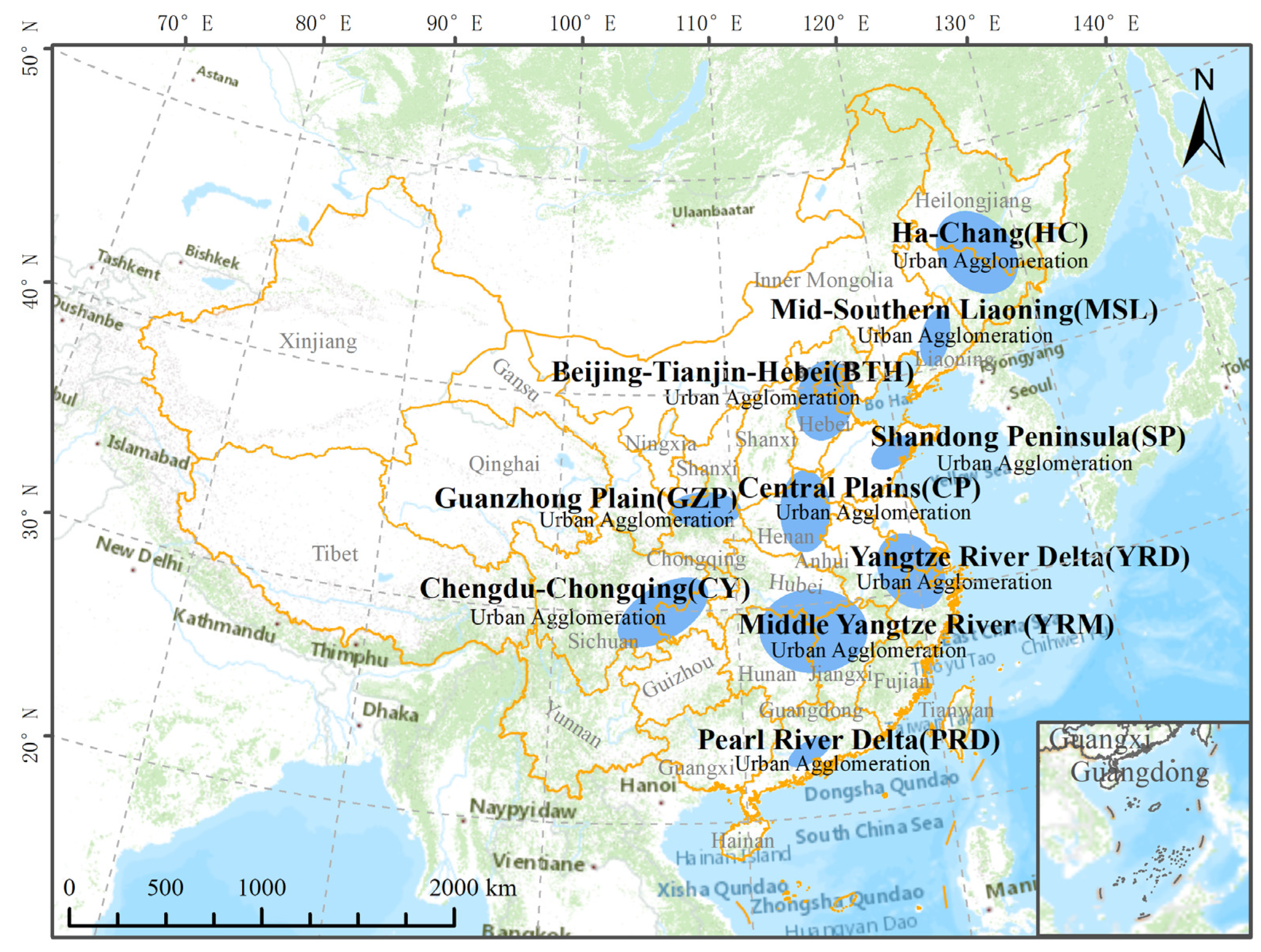
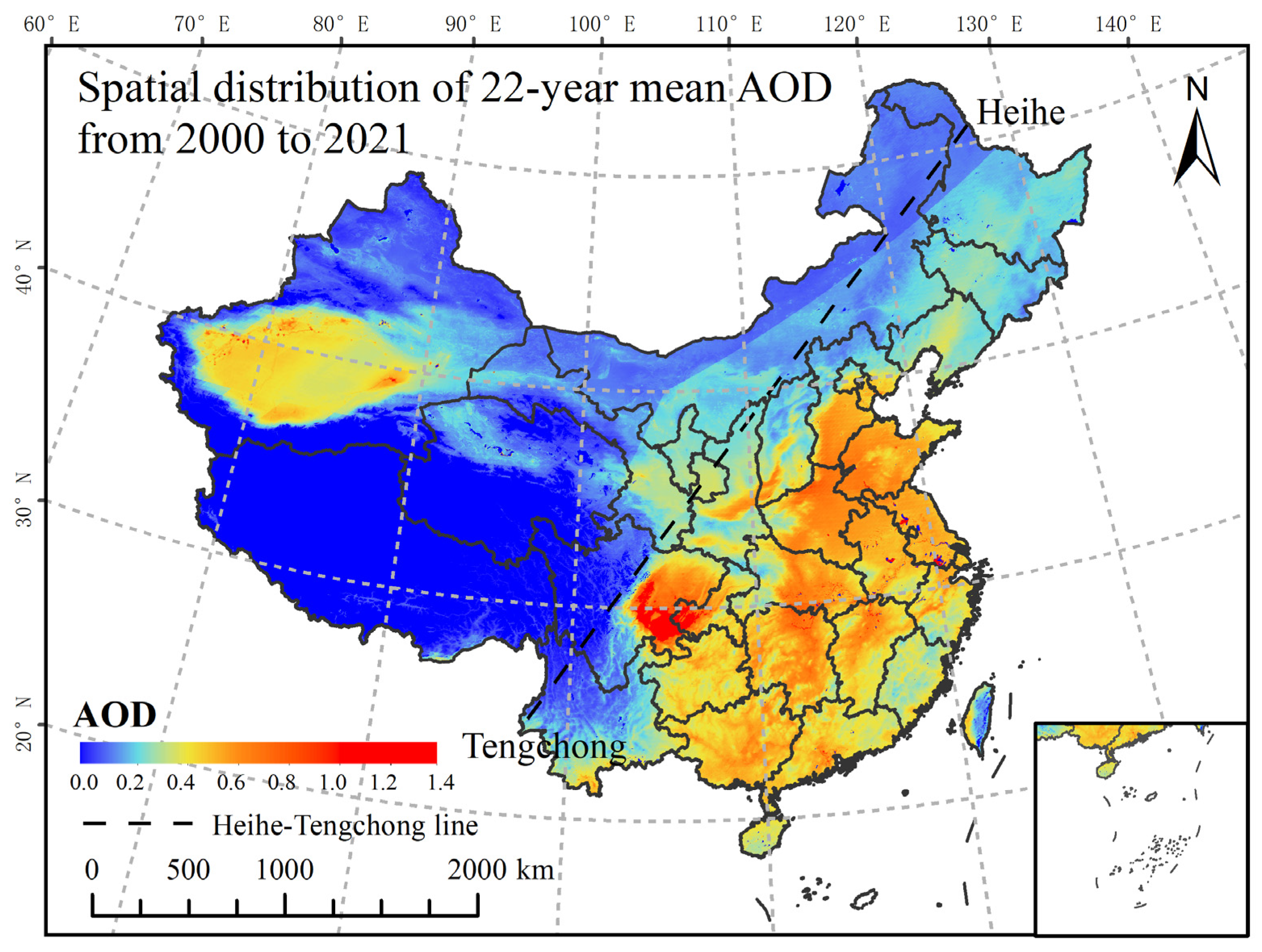
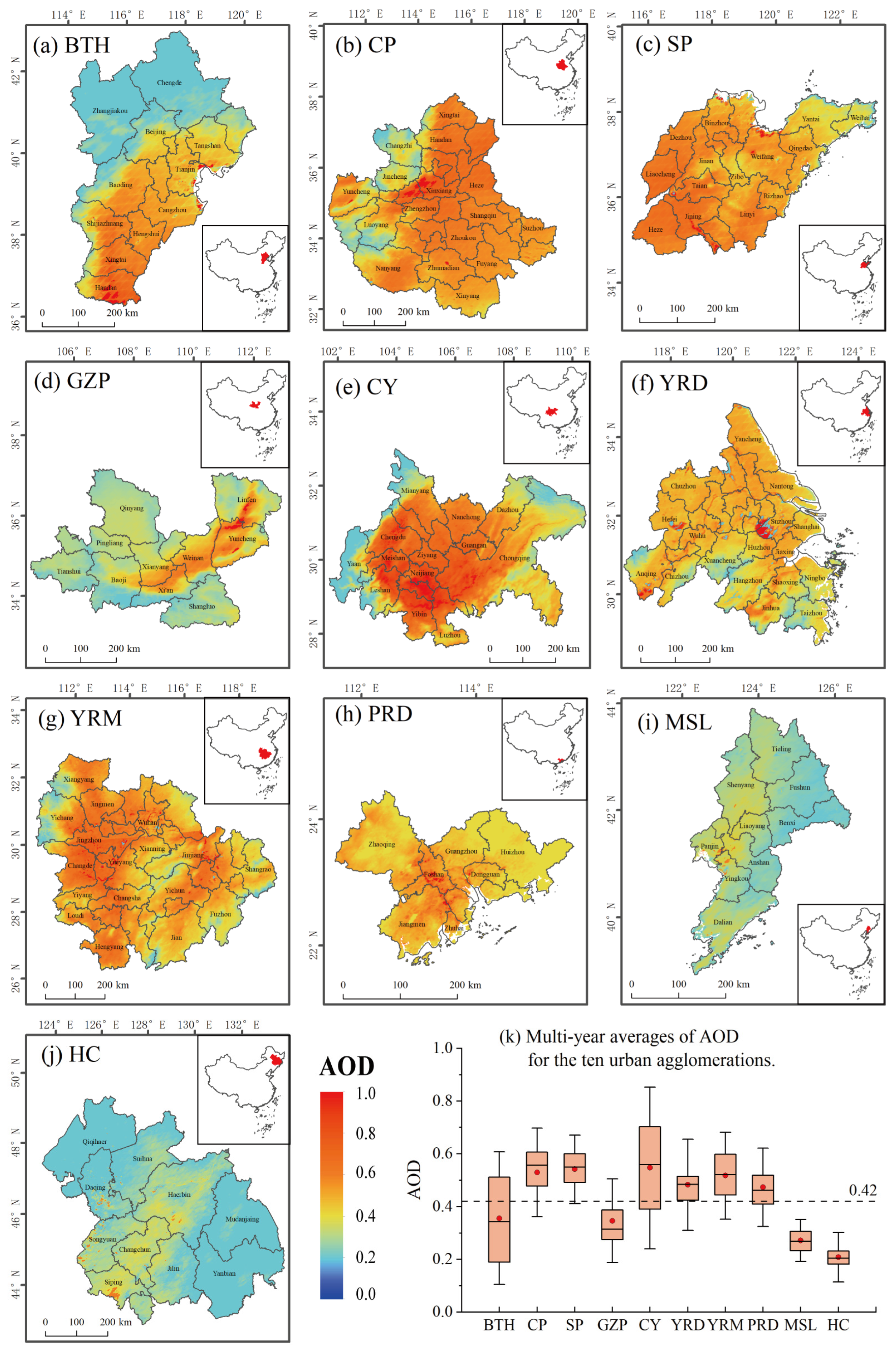
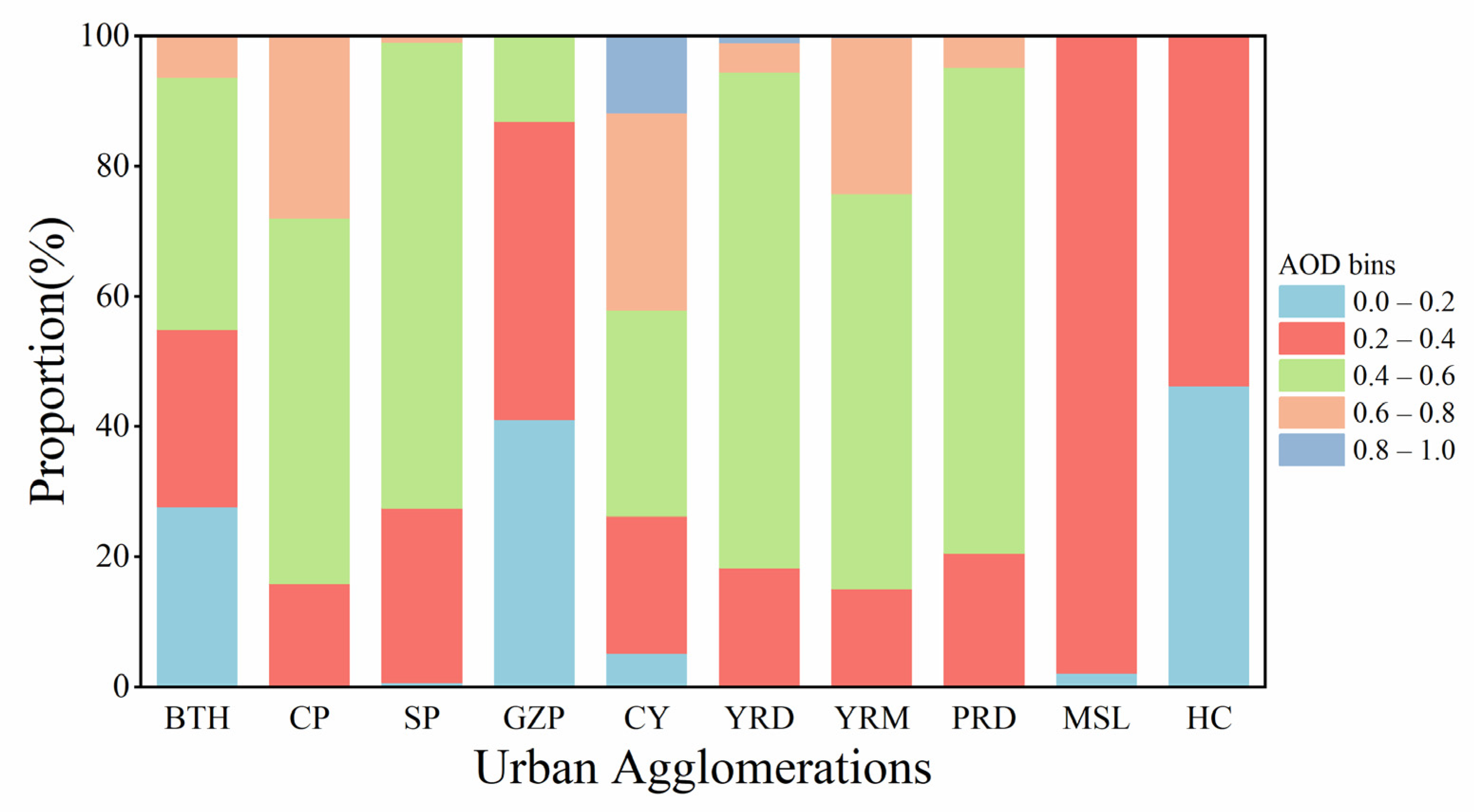
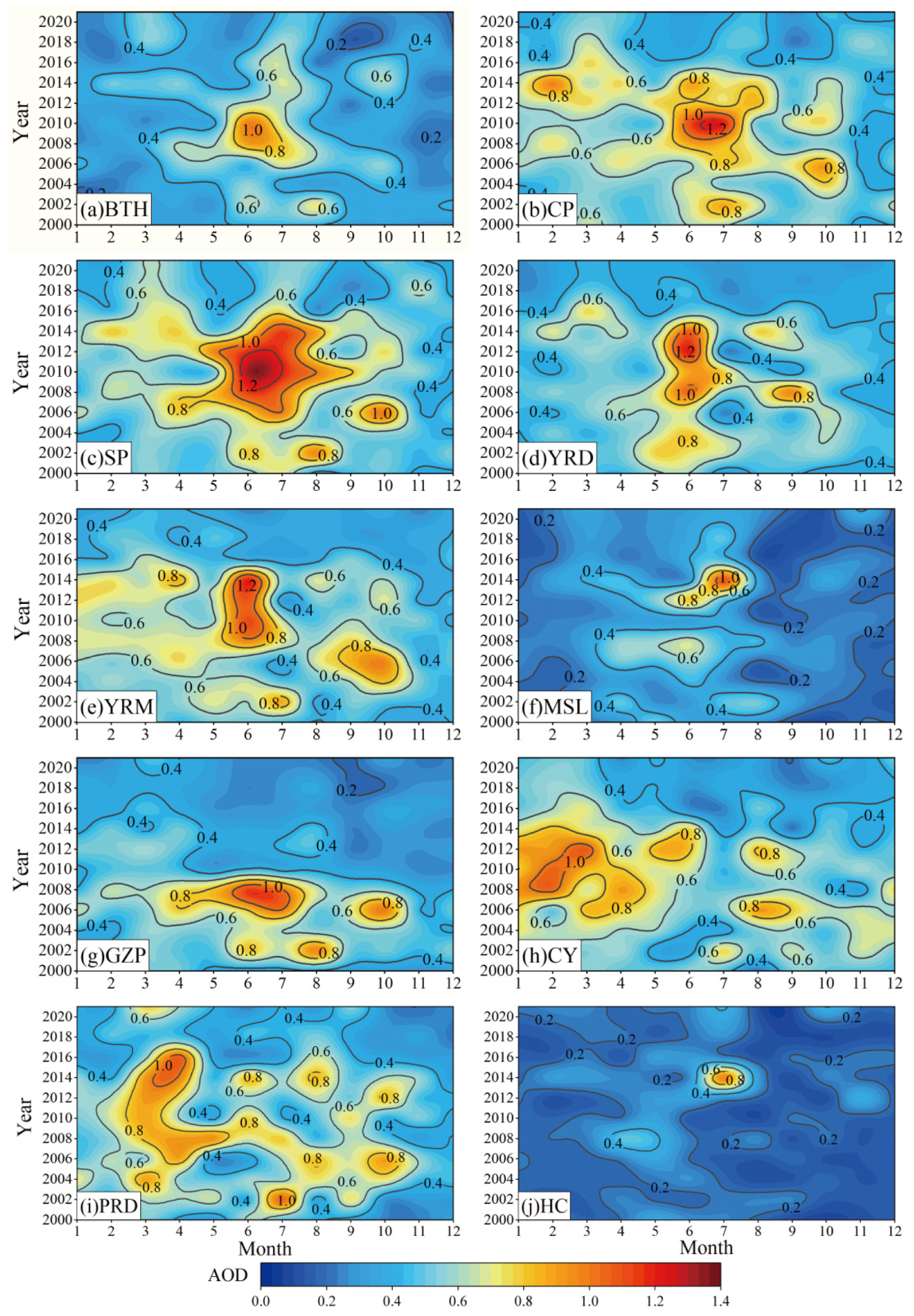
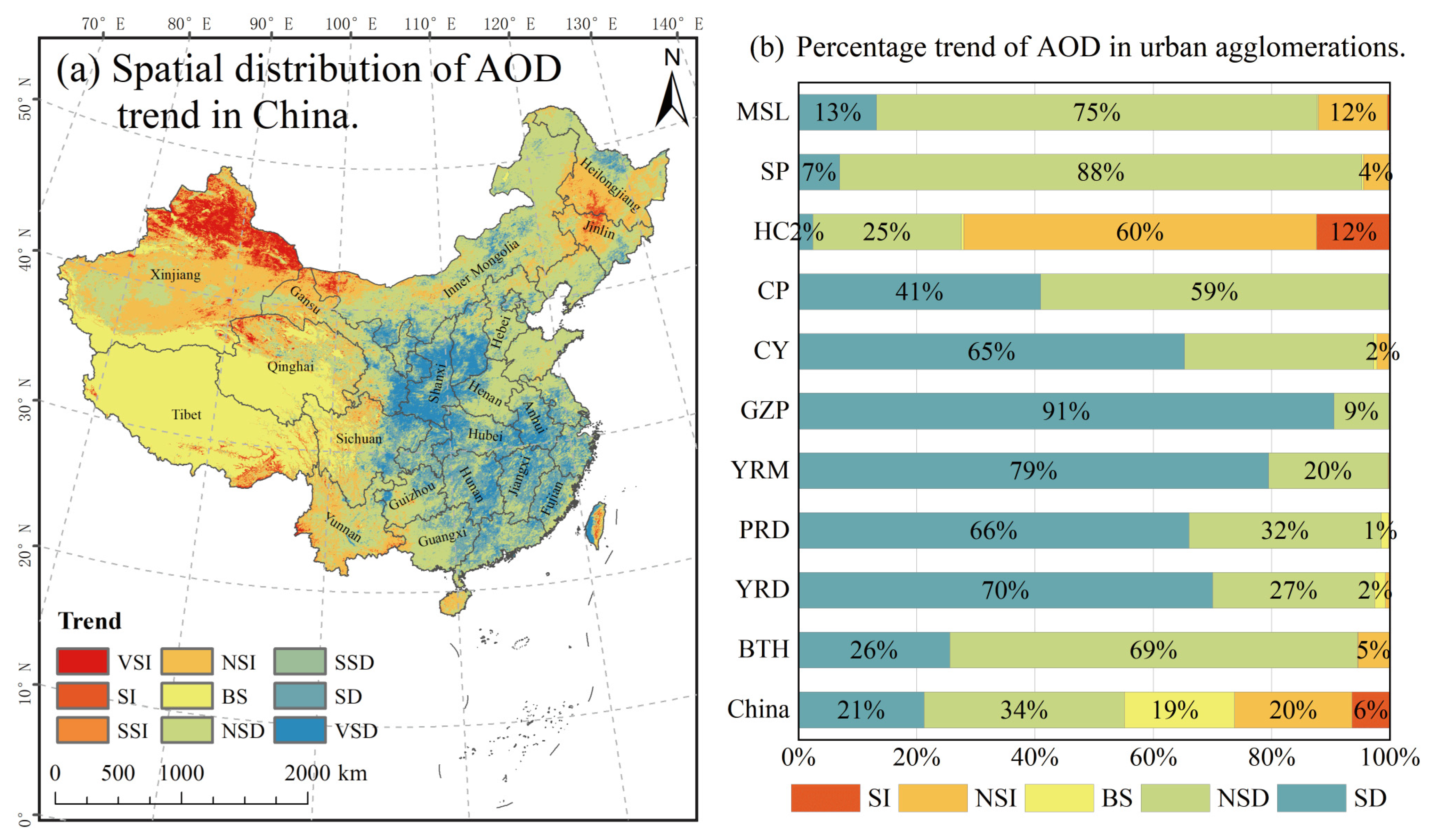

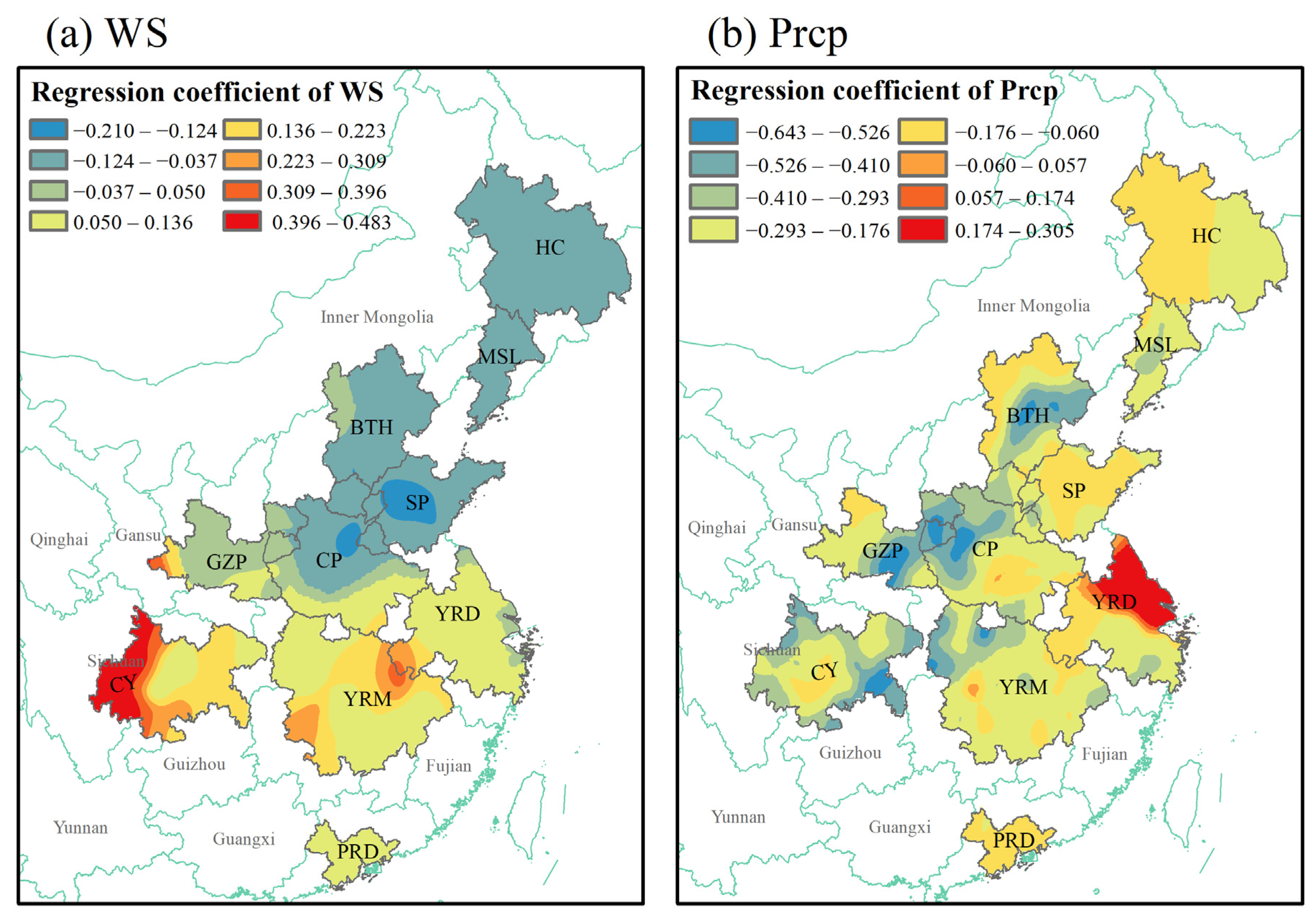

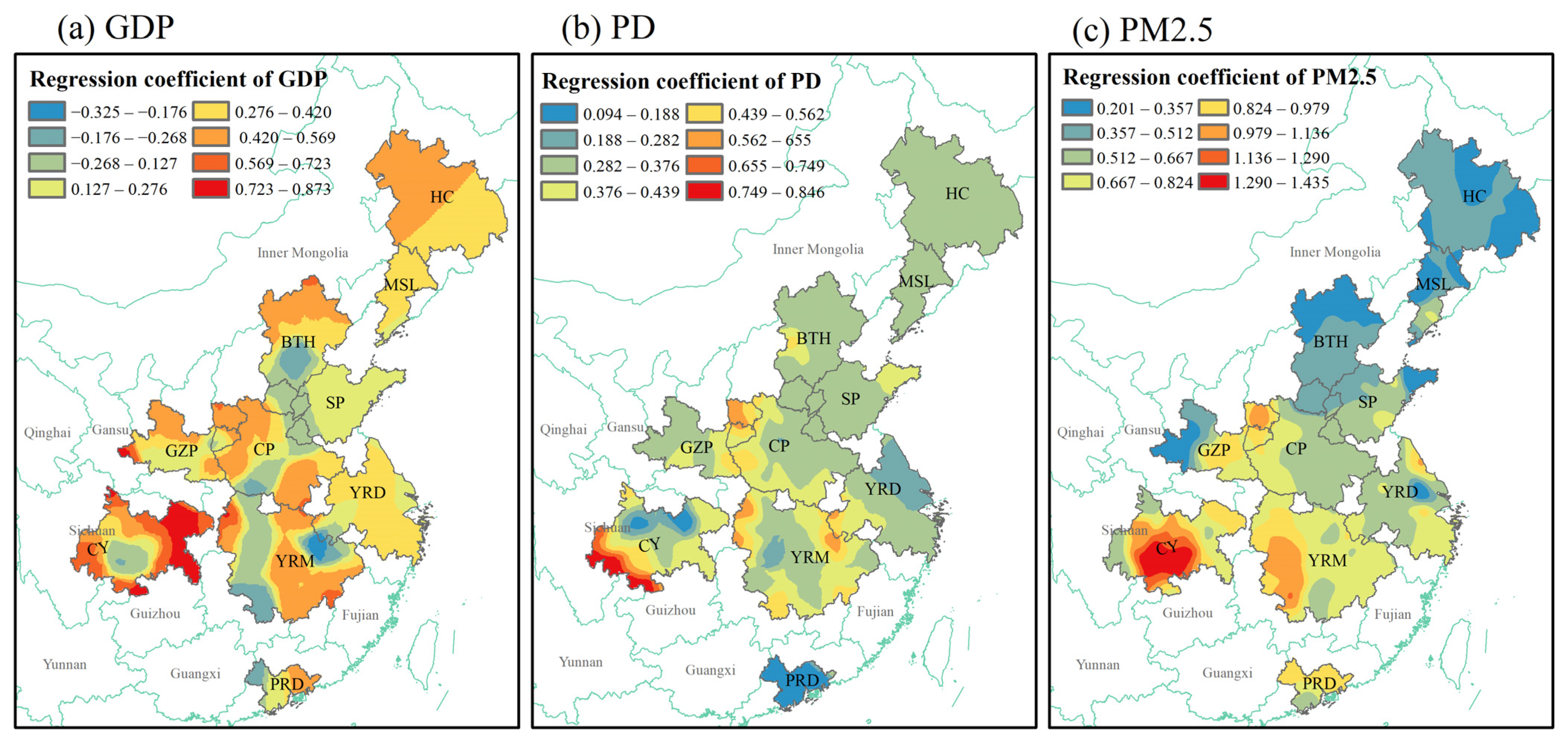
| Data Type | Data | Resolution | Data Source |
|---|---|---|---|
| Meteorological factors | Relative humidity (RH) | 1000 m 1 month (Tmp and RH are the near-surface product data) | National Earth System Science Data Center, National Science and Technology Infrastructure of China (http://www.geodata.cn (accessed on 8 November 2022)) [58] |
| Temperature (Tmp) | |||
| Precipitation (Prcp) | |||
| Wind speed (WS) | |||
| Topographic factors | Digital Elevation Model (DEM) | 1000 m | Resource and Environment Science and Data Center (https://www.resdc.cn/ (accessed on 4 November 2022)) |
| Slope | |||
| Surface characteristics factors | Normalized differential vegetation index (NDVI) | 250 m 16 d | (https://data.tpdc.ac.cn (accessed on 15 March 2023)) [59] |
| Land surface temperature (LST) | 1000 m 8 d | Resource and Environment Science and Data Center (https://www.resdc.cn/ (accessed on 7 April 2023)) | |
| Pollution indicator | PM2.5 | 1000 m | (https://weijing-rs.github.io/ (accessed on 20 February 2023)) [57] |
| Socioeconomic factors | Gross Domestic Product (GDP) | 1000 m | Resource and Environment Science and Data Center (https://www.resdc.cn/ (accessed on 8 June 2022)) |
| Population Density (PD) |
| 2000–2021 | R2021–2000 | 2000 | 2005 | 2010 | 2015 | 2021 | |
|---|---|---|---|---|---|---|---|
| China | 0.27 | −8.3 | 0.24 | 0.26 | 0.28 | 0.27 | 0.22 |
| M-UA | 0.42 | −11.9 | 0.38 | 0.44 | 0.45 | 0.44 | 0.32 |
| BTH | 0.36 | −9.1 | 0.33 | 0.34 | 0.36 | 0.38 | 0.30 |
| CP | 0.53 | −27.5 | 0.51 | 0.54 | 0.53 | 0.57 | 0.37 |
| SP | 0.54 | −10.6 | 0.47 | 0.54 | 0.60 | 0.60 | 0.42 |
| GZP | 0.35 | −25 | 0.36 | 0.37 | 0.34 | 0.36 | 0.27 |
| CY | 0.54 | −17.0 | 0.47 | 0.62 | 0.69 | 0.47 | 0.39 |
| YRD | 0.47 | −25 | 0.44 | 0.49 | 0.47 | 0.48 | 0.33 |
| YRM | 0.52 | −25 | 0.44 | 0.57 | 0.54 | 0.52 | 0.33 |
| PRD | 0.47 | −3.0 | 0.34 | 0.56 | 0.50 | 0.42 | 0.32 |
| MSL | 0.27 | 4.4 | 0.23 | 0.26 | 0.24 | 0.32 | 0.24 |
| HC | 0.21 | 18.8 | 0.16 | 0.16 | 0.18 | 0.24 | 0.19 |
| Z | Trend Categories | Trend Feature | Percentage Change of AOD in China | |
|---|---|---|---|---|
| 2.58 < Z | 4 | Very significantly increased (VSI) | 6.42% | |
| 1.96 < Z ≤ 2.58 | 3 | Significantly increased (SI) | ||
| 1.65 < Z ≤ 1.96 | 2 | Slightly significantly increased (SSI) | ||
| Z ≤ 1.65 | 1 | Nonsignificantly increased (NSI) | 19.85% | |
| Z | 0 | Basically stable (BS) | 18.64% | |
| Z ≤ 1.65 | −1 | Nonsignificantly decreased (NSD) | 33.89% | |
| 1.65 < Z ≤ 1.96 | −2 | Slightly significantly decreased (SSD) | 21.20% | |
| 1.96 <Z ≤ 2.58 | −3 | Significantly decreased (SD) | ||
| Z < 2.58 | −4 | Very significantly decreased (VSD) |
Disclaimer/Publisher’s Note: The statements, opinions and data contained in all publications are solely those of the individual author(s) and contributor(s) and not of MDPI and/or the editor(s). MDPI and/or the editor(s) disclaim responsibility for any injury to people or property resulting from any ideas, methods, instructions or products referred to in the content. |
© 2023 by the authors. Licensee MDPI, Basel, Switzerland. This article is an open access article distributed under the terms and conditions of the Creative Commons Attribution (CC BY) license (https://creativecommons.org/licenses/by/4.0/).
Share and Cite
Yuan, J.; Wang, X.; Feng, Z.; Zhang, Y.; Yu, M. Spatiotemporal Variations of Aerosol Optical Depth and the Spatial Heterogeneity Relationship of Potential Factors Based on the Multi-Scale Geographically Weighted Regression Model in Chinese National-Level Urban Agglomerations. Remote Sens. 2023, 15, 4613. https://doi.org/10.3390/rs15184613
Yuan J, Wang X, Feng Z, Zhang Y, Yu M. Spatiotemporal Variations of Aerosol Optical Depth and the Spatial Heterogeneity Relationship of Potential Factors Based on the Multi-Scale Geographically Weighted Regression Model in Chinese National-Level Urban Agglomerations. Remote Sensing. 2023; 15(18):4613. https://doi.org/10.3390/rs15184613
Chicago/Turabian StyleYuan, Jiaxin, Xuhong Wang, Zihao Feng, Ying Zhang, and Mengqianxi Yu. 2023. "Spatiotemporal Variations of Aerosol Optical Depth and the Spatial Heterogeneity Relationship of Potential Factors Based on the Multi-Scale Geographically Weighted Regression Model in Chinese National-Level Urban Agglomerations" Remote Sensing 15, no. 18: 4613. https://doi.org/10.3390/rs15184613
APA StyleYuan, J., Wang, X., Feng, Z., Zhang, Y., & Yu, M. (2023). Spatiotemporal Variations of Aerosol Optical Depth and the Spatial Heterogeneity Relationship of Potential Factors Based on the Multi-Scale Geographically Weighted Regression Model in Chinese National-Level Urban Agglomerations. Remote Sensing, 15(18), 4613. https://doi.org/10.3390/rs15184613






